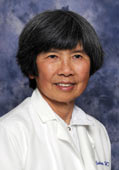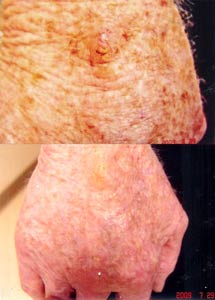Welcome to Rejuvenation Science®!
1-888-737-3588 TOLL FREE
Welcome to Rejuvenation Science®!
 ress on Anti-Aging and Biomedical Technologies in Orlando, FL.
ress on Anti-Aging and Biomedical Technologies in Orlando, FL.Concluding with a series of clinical before and after photos, Dr. Heng showed rapid repair with perfect regeneration in both acute injury (burns) and chronic injury (photodamaged skin). PsoriaGold, developed by Dr. Heng provides the patented formulation used in her clinical work.
Acute injury to the skin from burns and scalds result in blistering, and scarring, while chronic solar exposure from ultraviolet injury (UVA and UVB) result in photoaging, with thinning of the skin, red, scaly skin, pigmentary changes, loss of elasticity, and premalignant and malignant changes. Acute burns, if severe, frequently require skin grafting, with scarring as an inevitable result, while we have yet to find adequate preventive treatment against the changes in photoaging skin.
Recent interest has been focused on curcumin,a phosphorylase kinase inhibitor, for the repair of both acute burns, and chronically photodamaged skin through inhibition of NF-kB-dependent pathways mediated by phosphorylase kinase. We discuss phosphorylase kinase-mediated signaling pathways targeted by curcumin as a basis for stimulating repair of both acute burns and chronic solar skin damage, and present a clinical series supporting the efficacy of topical curcumin gel in burns and photoaging skin.
 ***Photodamaged skin with advanced actinic keratosis and severe solar elastosis (upper panel) improved after 6 months with topical curcumin gel (Psoria-Gold) applied twice daily (lower panel). Note resolution of both the actinic keratosis and improvement in solar elastosis.***
***Photodamaged skin with advanced actinic keratosis and severe solar elastosis (upper panel) improved after 6 months with topical curcumin gel (Psoria-Gold) applied twice daily (lower panel). Note resolution of both the actinic keratosis and improvement in solar elastosis.***
Acute injury to the skin from burns and scalds result in blistering, and scarring, while chronic solar exposure from ultraviolet injury (UVA and UVB) result in photoaging, with thinning of the skin, red, scaly skin, pigmentary changes, loss of elasticity, and premalignant and malignant changes. Acute burns, if severe, frequently require skin grafting, with scarring as an inevitable result, while we have yet to find adequate preventive treatment against the changes in photoaging skin. Recent interest has been focused on topical curcumin (Psoria-Gold), a phosphorylase kinase inhibitor, for the repair of both acute burns, and chronically photodamaged skin through inhibition of NF-kB-dependent pathways mediated by phosphorylase kinase.
In injured skin resulting in DNA damage, the DNA-damage response severely suppresses cell proliferation by causing cell cycle arrest. This impairs the healing process. We have found that curcumin gel, by selectively enhancing apoptosis in damaged cells through inhibition of phosphorylase kinase, results in rapid removal of the damaged cells, thus overcoming the inhibitory effects of the DNA damaged cells in causing cell cycle arrest. The removal of the damaged cells allows room for proliferation of new healthy cells, resulting in rapid repair with perfect regeneration in both acute injury (burns) and chronic injury (photodamaged skin).
Clinical Professor of Medicine/Dermatology, UCLA School of Medicine,1990 - present
Dermatologist, Centers for Family Health, Oxnard, CA,Mar, 2006 –present
Associate Professor of Medicine/Dermatology, UCLA School of Medicine,1984 - 1990
Chief, Division of Dermatology, Veterans Administration MedicalCenter, Sepulveda, CA., Oct 1979-Jan 2003
Author of over 70 published articles in peer-reviewed journals.
Editorial Boards:
Journal of the American Academy of Dermatology, 1985 to present
American Journal of Geriatric Medicine, 1988 to present
International Journal of Angiology, 1994 to present
Lancet, London, 1995 to present
International Journal of Dermatology, 2009 to present
M.B., B.S. (MD) 1967 University of Singapore
CERTIFICATION 1968 Educational Council for Foreign Medical Graduates
M.R.A.C.P. 1971 Member, Royal Australasian College of Physicians
M.A.C.D. 1973 Member, Australasian College of Dermatologists
F.R.A.C.P. 1975 Fellow, Australasian College of Physicians
F.A.C.D. 1976 Fellow, Australasian College of Dermatologists
FLEX 1976 Federation Licensing Examination